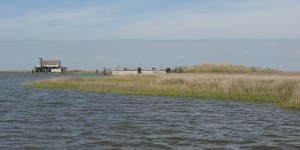Ecological studies show that bottom-up (e.g., nutrient input) and top-down (e.g., grazing/predation) pressuresmay change the structure of aquatic ecosystems with 'cascading' effectsthroughoutthe food chain. Recent research supportsthat zooplankton grazing in high-nutrient waters promotes the growth of largerphytoplankton over smaller species, creating a higher abundance of these larger single celled algae withinthe food web.
Using samples from three nutrient enriched southeastern Louisiana bayou lakes (Cataouatche, Lac des Allemands, Salvador), researchers with the NCCOS-funded Barataria Bay Multiple Stressors project at Louisiana State University and Louisiana Universities Marine Consortium conducted experiments on nutrient additions with zooplankton grazing. Unlike previous single species laboratory experiments, they used whole water samples with entire phyto-and zooplankton species composition and maintainedunder natural conditions to test the hypothesis.

Southeastern Louisiana freshwater and brackish lakes and bayous are subject to nutrient inputs from Mississippi River diversions. Credit: Louisiana State University
The researchers hypothesized that grazing on phytoplankton by the microzooplankton community (e.g., rotifers) is size-dependent; top-down control of phytoplankton by the microzooplankton explains why small phytoplankton become less abundant than large phytoplankton in eutrophic waters. Using the 'dilution method,' the experiment tested the whole microzooplankton community and providedsolid evidence that microzooplankton grazing on phytoplankton explains why the average size of phytoplankton, whether as isolated cells or as colonies, tends to increase in eutrophic waters.
The research is published on the scientific journal Hydrobiologia .
For more information, contact David.Scheurer@noaa.gov.
 Official websites use .gov
A .gov website belongs to an official government organization in the United States.
Official websites use .gov
A .gov website belongs to an official government organization in the United States. Secure .gov websites use HTTPS
A lock or https:// means you’ve safely connected to the .gov website. Share sensitive information only on official, secure websites.
Secure .gov websites use HTTPS
A lock or https:// means you’ve safely connected to the .gov website. Share sensitive information only on official, secure websites.